Unravel the weariness of boring gym routines and the quest for costly workout equipment. If you seek an invigorating and efficient path to enhance your fitness without the complexities of specialised gear, you’ve landed in the right domain.
Welcome to the realm of Circuit Training Exercises Without Equipment – a revolutionary methodology to accomplish your fitness aspirations right within the comforts of your abode or any appropriate expense.
Circuit training embodies a dynamic workout modality that combines cardiovascular and strength exercises, empowering you to target numerous muscle clusters and elevate your heart rate for optimal outcomes.
Bid adieu to the confinement of the gym and embrace the versatility of bodyweight exercises that will leave you inspired, invigorated, and primed to triumph over your fitness odyssey.
What is Circuit Training?
Circuit training is a highly effective workout approach that combines cardiovascular and strength exercises in a series of consecutive movements or “stations.”
This training method has gained popularity due to its time-efficiency, versatility, and ability to deliver full-body results without the need for specialized gym equipment.
In a circuit, participants move from one exercise to another with minimal rest intervals, providing a challenging and continuous workout that targets multiple muscle groups while elevating the heart rate.
In a comprehensive review of the literature on circuit training, the Journal of Strength and Conditioning Research highlighted the versatility of this training method.
Circuit training can be tailored to meet the needs of various populations, including athletes, sedentary individuals, and those with chronic health conditions.
The research emphasized the adaptability and scalability of circuit training as a workout modality.
Benefits of Circuit Training Without Equipment
Circuit training sans equipment confers an array of advantages that shall revolutionize your fitness regimen, ensuring efficient and effective goal attainment.
Whether you find yourself a busy professional, a stay-at-home parent, or merely an individual drawn to the convenience of home workouts, circuit training emerges as the ideal solution.
Let us delve into the tangible merits supported by research and evidence, elucidating why this approach garners global acclaim among fitness enthusiasts.
1. Convenience and Accessibility:
The foremost boon of equipment-free circuit training lies in its unmatched convenience and accessibility. Free from the need for gym memberships or specialized apparatus, exercising becomes facile anytime and anywhere.
No longer shall you rush to the gym or await your turn on machines – unroll your yoga mat or discover a cozy space, and you’re all set.
A study cited in the Journal of Sport and Health Science establishes that bodyweight exercises integrated into circuit training present an accessible and effective avenue to enhance muscular strength and cardiovascular fitness, catering to individuals of varying fitness levels.
2. Full-Body Workout:
Circuit training embodies a time-efficient workout technique, engaging multiple muscle groups simultaneously.
Sequentially performing exercises with brief intervals, you activate both cardiovascular and muscular systems, affording a comprehensive workout that maximizes calorie expenditure and boosts overall fitness (*).
Findings from the study revealed that circuit training elicited significant increases in heart rate and oxygen consumption compared to traditional steady-state aerobic exercise (*).
The participants burned a higher number of calories during the 30-minute circuit session, indicating its effectiveness in maximizing calorie expenditure.
3. Versatility and Variety:
Circuit training unleashes boundless workout possibilities, allowing personalization with an extensive array of bodyweight exercises targeting diverse muscle clusters.
From squats and push-ups to mountain climbers and burpees, the profusion of movements keeps workouts novel and engaging.
The British Journal of Sports Medicine advocates incorporating various exercises in circuit training to foster heightened muscular adaptation and circumvent workout plateaus, perpetually challenging and advancing your fitness journey.
4. Time-Efficient and Effective:
For those beset by time constraints yet yearning for optimal outcomes, circuit training holds the answer. By amalgamating strength and cardiovascular training, this form of workout saves valuable time while preserving efficacy.
A study published in the American Journal of Physiology ascertains that circuit training yields substantial enhancements in cardiorespiratory fitness and muscular strength, epitomizing an efficient path to realizing fitness aspirations without excessive hours at the gym.
5. Suitable for All Fitness Levels:
Adaptable to diverse fitness levels, circuit training caters to beginners and seasoned athletes alike. The flexibility to regulate exercise intensity and duration aligns the regimen with your capabilities, facilitating gradual progress as you cultivate strength and endurance.
A research study featured in the Journal of Sports Science confirms the adaptability and scalability of circuit training, positioning it as an inclusive and effective workout modality for a wide spectrum of individuals.
Warm-Up Routine
Prior to delving into equipment-free circuit training, a proper warm-up assumes paramount importance. Warming up augments blood flow to your muscles, elevates heart rate, and optimises overall performance while mitigating the risk of injury.
Adhere to this dynamic warm-up routine to ensure your body stands primed and prepared to conquer the circuit workout:
- Jumping Jacks (2 minutes): Embark on this timeless exercise that invigorates your heart and sets your body in motion. Assume a stance with feet together and arms resting by your sides. Leap, parting your legs while simultaneously raising your arms overhead. Jump once more to return to the initial position. Engage in this routine for 2 minutes to elevate your heart rate and warm up your entire physique.
- Arm Circles (1 minute): Take a stance with feet shoulder-width apart. Extend arms laterally at shoulder level. Initiate small circular motions with your arms, progressively expanding the circles. After 30 seconds, alter the direction. This exercise primes your shoulder joints and fosters improved mobility.
- Leg Swings (1 minute each leg): Secure support from a stable surface like a wall or chair. Execute controlled forward and backward swings with one leg. Repeat for 30 seconds, then switch to the other leg. This exercise loosens your hip flexors and enhances flexibility.
- Hip Rotations (1 minute each side): Stand with feet hip-width apart. Position your hands on your hips and commence circular rotations. After 30 seconds, switch directions. This exercise preps your hip joints for motion during the workout.
- High Knees (1 minute): Stand with feet hip-width apart. Initiate jogging in place, lifting your knees as high as possible. Employ arm movements to intensify the exercise. High knees elevate the heart rate and activate leg muscles.
- Arm Crosses (1 minute): Stand with feet hip-width apart, extending arms laterally. Cross one arm over the other in front of your chest, then switch arms. Maintain controlled and continuous movements. This exercise warms up your chest and shoulder muscles.
- Bodyweight Squats (1 minute): Perform several bodyweight squats to further prepare your lower body. Assume a stance with feet shoulder-width apart, squat down akin to sitting in a chair, and return to a standing position. This exercise engages your quads, hamstrings, and glutes.
Circuit Training Exercises
1. Bodyweight Squats
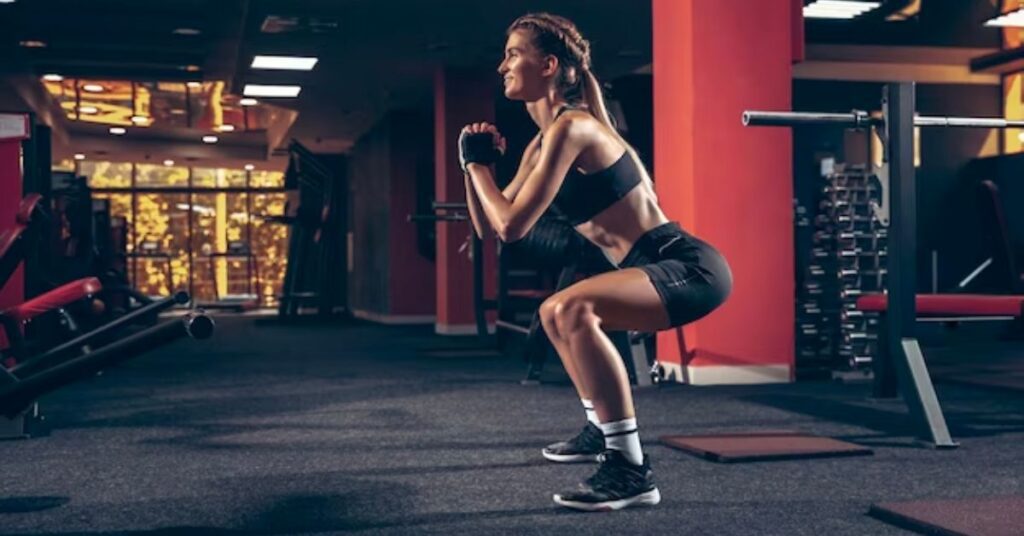
When it comes to circuit training without equipment, bodyweight squats are a fundamental exercise that can greatly enhance your lower body strength and overall fitness.
This essential movement mimics the action of sitting down and standing up, making it a functional exercise for everyday life.
Whether you want to improve athletic performance, tone your legs, or enhance daily movements, bodyweight squats are the go-to exercise for your circuit routine.
Let’s explore the steps to perfecting this effective exercise:
Steps:
- Starting Position: Stand with your feet slightly wider than shoulder-width apart, toes pointing slightly outward. Keep your back straight, chest lifted, and engage your core muscles for stability.
- Lowering Phase: Initiate the movement by pushing your hips back as if you are sitting in an imaginary chair. Bend your knees and lower your body down, keeping your weight centered on your heels.
- Depth of Squat: Aim to lower down until your thighs are parallel to the ground, or as far as your flexibility allows without compromising your form. Maintaining proper form is essential to prevent injury.
- Upright Posture: As you reach the bottom of the squat, make sure your knees are in line with your toes, and your chest remains lifted. Avoid rounding your back.
- Ascending Phase: To return to the starting position, push through your heels and engage your glutes and quadriceps to stand back up. Keep your core tight throughout the movement.
- Breathing: Inhale as you lower down into the squat and exhale as you push back up to the starting position. Focus on controlled breathing throughout the exercise.
Tips for Proper Form:
- Keep your knees aligned with your toes throughout the squat.
- Avoid leaning too far forward or backward; maintain an upright posture.
- Engage your core muscles to stabilize your spine during the movement.
- If you’re new to squats or working on your form, start with a shallow squat and gradually increase the depth as you become more comfortable.
- Focus on maintaining a steady and controlled pace during the exercise.
2. Push-Ups
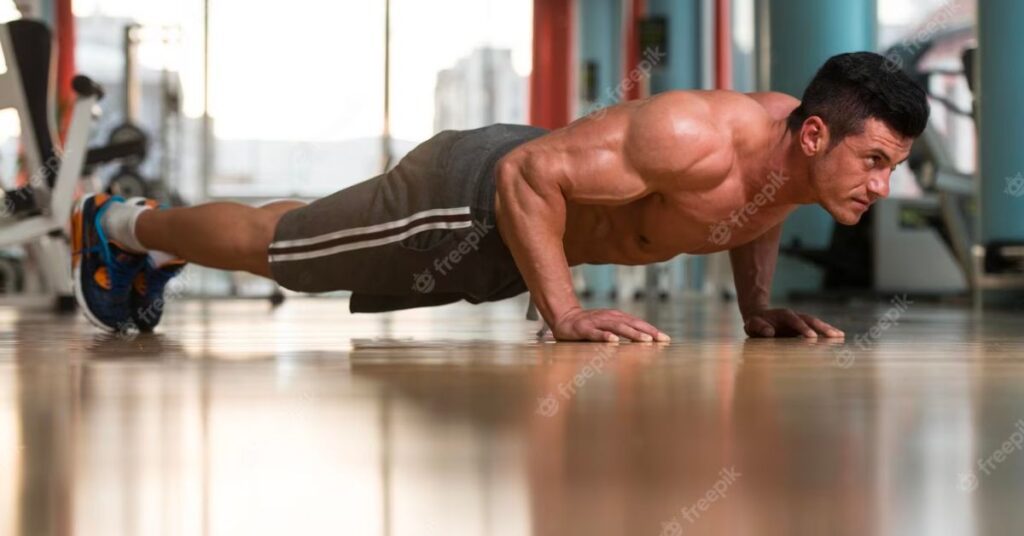
When it comes to building upper body strength and sculpting your arms, push-ups are a timeless classic in the world of circuit training without equipment.
This versatile bodyweight exercise targets your chest, shoulders, triceps, and core, making it a fundamental move for anyone looking to tone and strengthen their upper body.
Let’s delve into the steps to master the art of push-ups:
- Find Your Starting Position: Begin by positioning yourself in a high plank position with your hands placed slightly wider than shoulder-width apart. Your arms should be straight, and your wrists should align with your shoulders. Engage your core to maintain a straight line from your head to your heels.
- Lower Your Body: Lower your body towards the floor by bending your elbows. Keep your elbows close to your body at about a 45-degree angle. Lower yourself until your chest is just above the ground or as far as your strength allows.
- Push Back Up: Push through your palms to extend your arms and return to the starting position. Exhale as you push back up. Ensure your body remains in a straight line throughout the movement and avoid letting your hips sag or your back arch.
- Modify Your Fitness Level: If regular push-ups are too challenging, don’t worry! There are modifications to suit every fitness level. To make it easier, perform push-ups on your knees while maintaining proper form. This reduces the amount of bodyweight you’re lifting, making it more manageable.
3. Mountain Climbers
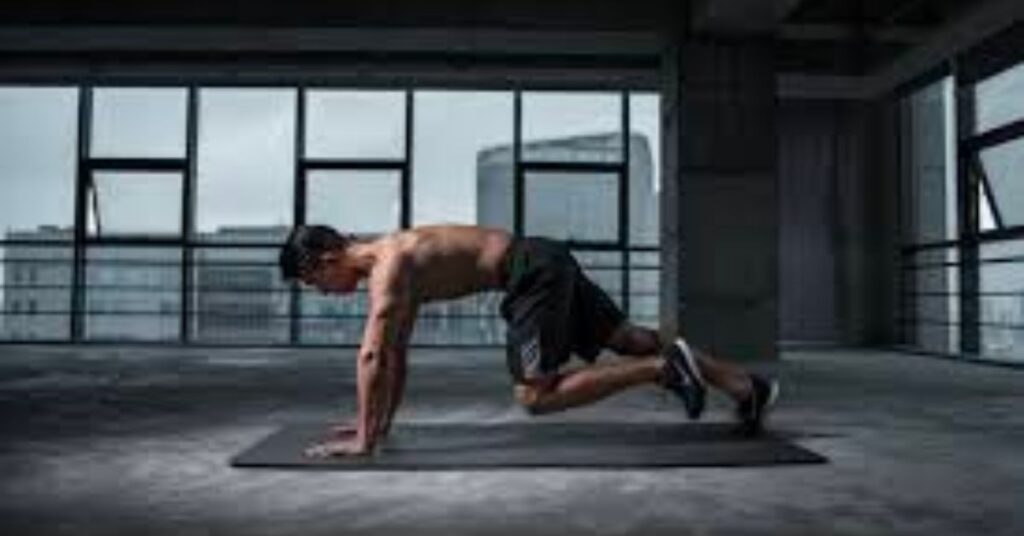
When it comes to circuit training exercises without equipment, mountain climbers are a dynamic and challenging movement that targets multiple muscle groups and elevates your heart rate.
Imagine yourself on a mountainside, propelling your body forward as you conquer each ascent. Mountain climbers mimic this climbing motion, making you feel like an adventurous mountaineer right in the comfort of your workout space.
Let’s break down the steps to master mountain climbers and add them to your circuit training routine:
Step 1: Set Up the Position
- Start in a plank position with your hands placed firmly on the ground, directly beneath your shoulders.
- Extend your legs straight out behind you, forming a straight line from your head to your heels.
- Engage your core muscles to keep your body stable throughout the exercise.
Step 2: Begin the Climb
- Drive your right knee towards your chest, engaging your lower abs as you bring the knee as close as you comfortably can.
- As you extend your right leg back to the starting position, simultaneously bring your left knee towards your chest.
- Keep the motion continuous and fluid, creating a “running” motion with your legs while holding the plank position with your upper body.
Step 3: Pick Up the Pace
- Once you get the hang of the movement, increase your speed to elevate your heart rate and add a cardio boost to your circuit training routine.
- Challenge yourself to maintain a steady pace, keeping the intensity throughout the set.
4. Diverse Plank Variations
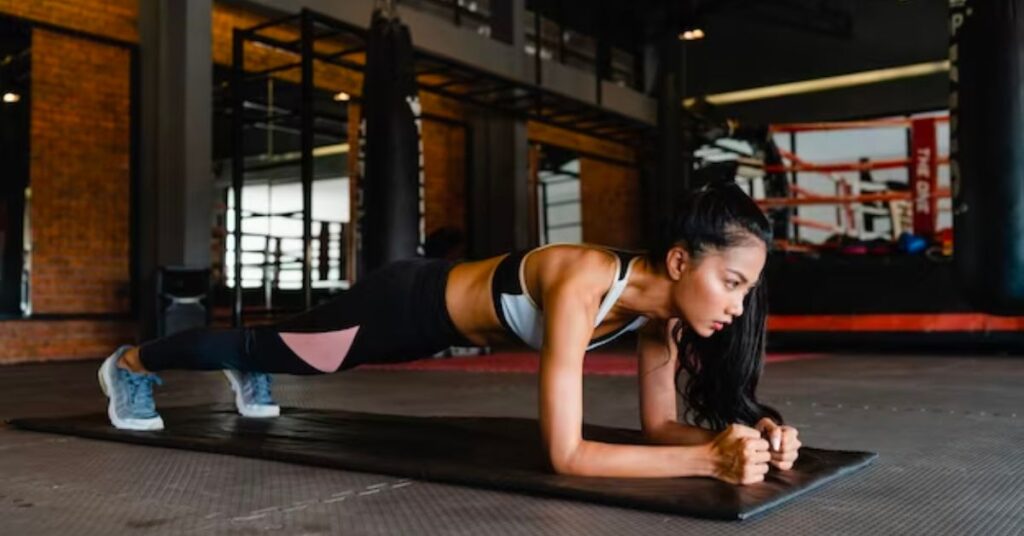
When it concerns cultivating a robust and stable core, plank variations reign as the ultimate holy grail of bodyweight exercises.
Planks engage not only your abdominal muscles but also your back, shoulders, and glutes, rendering them an indispensable inclusion in your circuit training regimen.
Allow us to explore some real-life plank variations that intertwine seamlessly, challenging your core and elevating your overall fitness level.
Standard Plank:
- Commence by assuming a push-up position, with palms firmly planted on the ground directly under your shoulders.
- Activate your core muscles and maintain a straight line from head to heels.
- Sustain the plank position for as long as possible, aiming for at least 30 seconds as a starting point.
- Focus on upholding proper form, eschewing any arching or sagging of your back.
Side Plank:
- Lie on your side, stacking your legs atop one another.
- Support your body weight on one forearm, ensuring your elbow is beneath your shoulder.
- Elevate your hips off the ground, establishing a straight line from head to heels.
- Engage your obliques and hold the position for 30 seconds.
- Repeat on the opposite side to engage both sides of your core.
Plank with Shoulder Taps:
- Assume the standard plank position with your body aligned in a straight line.
- Lift one hand off the ground and tap the opposite shoulder.
- Return to the starting position and replicate the action on the other side.
- Focus on maintaining stable hips and minimizing any swaying or rocking.
Spiderman Plank:
- Commence in the standard plank position.
- Bring your right knee towards your right elbow, engaging your obliques.
- Return your right leg to the starting position and repeat on the left side.
- Alternate legs in a controlled manner for 30 seconds.
Plank Jacks:
- Initiate from the standard plank position.
- Jump both feet out wide and then back together, mirroring the motion of a jumping jack.
- Keep your core engaged and upper body stable throughout the exercise.
- Perform plank jacks for 30 seconds, aiming for a quick yet controlled pace.
Plank Up-Downs:
- Begin in a forearm plank position, with elbows directly under your shoulders.
- Push up onto your right hand, then your left hand, transitioning into a full plank position.
- Lower yourself back down onto your right forearm, then your left forearm.
- Alternate between forearm and full plank positions for 30 seconds.
Plank Knee-to-Elbow:
- Initiate from the standard plank position.
- Draw your right knee towards your right elbow, engaging your obliques.
- Extend your right leg back to the plank position and repeat on the left side.
- Alternate knee-to-elbow movements for 30 seconds.
5. Leap Lunges
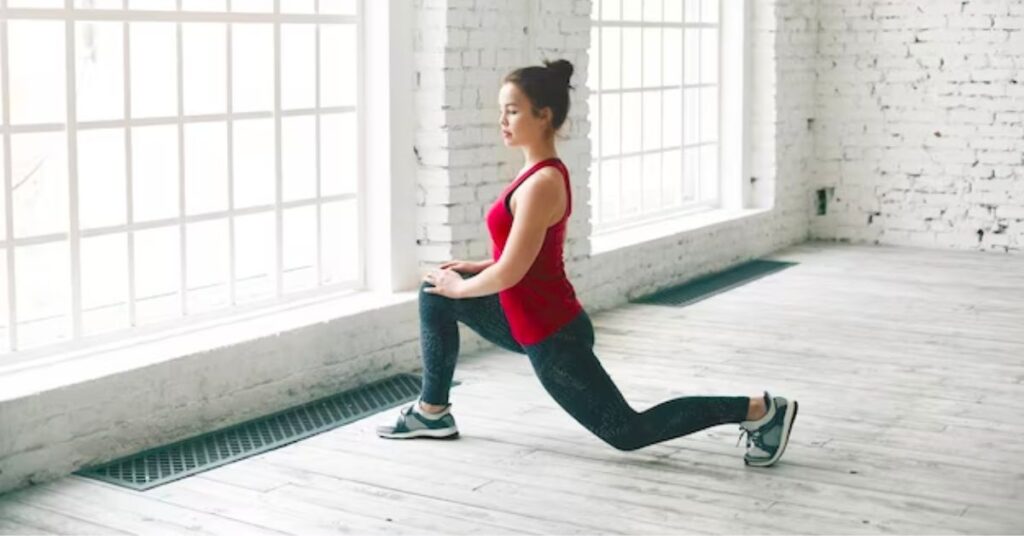
When it comes to circuit training exercises, few maneuvers rival the efficacy and exhilaration of Leap Lunges.
This dynamic bodyweight exercise targets your lower body muscles, delivering an intense workout that enhances strength, power, and endurance. As you execute Leap Lunges, your heart rate escalates, and your muscles come alive, making it a superb supplement to your circuit routine.
Prepare to elevate your fitness to new pinnacles with these straightforward steps:
Steps to Execute Leap Lunges:
- Step 1: Proper Stance: Commence in a standing position with feet hip-width apart. Maintain a lifted chest, relaxed shoulders, and engaged core for stability.
- Step 2: Lunge Position: Take a forward step with your right foot, lowering your body into a lunge. Both knees should be bent at a 90-degree angle, with your right knee directly over your ankle. Your left knee should hover slightly above the ground.
- Step 3: Explosive Leap: In a dynamic motion, propel yourself off the ground with both feet and jump into the air. During the jump, switch the position of your legs, bringing your left foot forward and your right foot back.
- Step 4: Land Softly: Touch down gently with your left foot forward and your right foot back, transitioning immediately into a lunge position. Ensure that both knees maintain a 90-degree angle, and your left knee aligns directly above your ankle.
- Step 5: Repeat: Instantly proceed into the next repetition with another leap and leg switch. Continue this alternating motion, performing consecutive leap lunges.
Tips for Proper Form:
- Maintain an upright upper body, abstaining from leaning excessively forward or backward during the exercise.
- Execute smooth and controlled movements during lunges and jumps to prevent joint strain.
- Land softly with each leap to minimize impact on your knees and ankles.
- Commence with a lower number of repetitions and progressively increase as strength and stability grow.
6. Triceps Dips
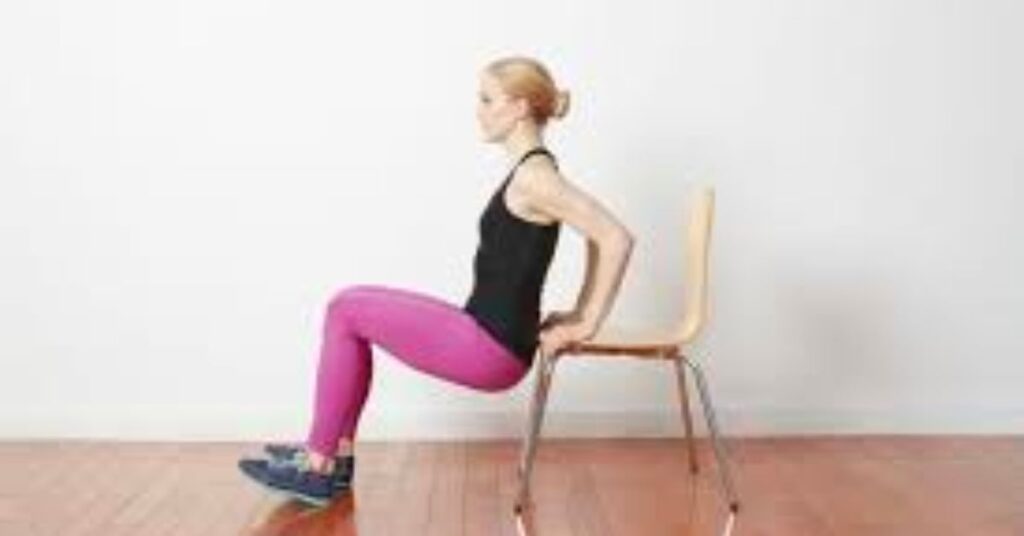
If you’ve envisioned exhibiting firm and toned arms sans fancy gym equipment, Triceps Dips hold the key to your aspirations.
This effective bodyweight exercise embodies a pillar of circuit training routines, strategically targeting and sculpting your triceps – the muscles adorning the back of your upper arms.
Triceps Dips not only amplify arm strength but also activate your core and shoulder muscles, constituting a bona fide full-body workout.
Awaken the prowess of your triceps and incorporate this empowering exercise into your circuit training regimen with ease using these simple steps:
- Locate a Sturdy Surface: To perform Triceps Dips, identify a stable surface such as the edge of a sturdy chair, bench, or low table. Ensure that the surface supports your body weight securely, devoid of wobbling or tipping.
- Position Your Hands: Sit on the edge of the chosen surface with hands positioned beside your hips, gripping the edge firmly. Your fingers should face forward, and palms should rest flat against the surface. Opt for forward-facing fingers for a more triceps-focused workout or slightly inward-turned fingers to involve your chest muscles.
- Slide Forward: Gradually slide your feet forward, allowing your hips to lift off the surface. Keep your knees bent at a 90-degree angle, and your feet should rest flat on the floor. Your weight should be supported by your hands and heels.
- Lower Your Body: Bend your elbows and descend your body downward. Aim for a 90-degree angle with your arms, ensuring that your elbows point directly behind you, not to the sides. Maintain control throughout the movement, avoiding descending too low, which may strain your shoulders.
- Push Back Up: Execute a steady and controlled motion to push yourself back up into the starting position. Extend your elbows fully but abstain from locking them. Maintain core engagement to preserve stability throughout the exercise.
- Breathe Properly: Remember to breathe during the exercise. Inhale as you lower your body and exhale as you push back up.
- Repeat the Reps: Begin with 10-12 repetitions in your circuit training routine. Gradually increase the number of repetitions or add extra sets as you develop strength.
- Modifications for Beginners: If Triceps Dips seem overly challenging initially, increase the angle of your bent knees to reduce resistance. Alternatively, perform the exercise with your feet on the floor and hands on a higher surface, such as a countertop.
7. Bicycle Crunches

Among circuit training exercises without equipment, Bicycle Crunches emerge as a standout move, promising to engage your core like never before.
This exercise mimics the motion of riding a bicycle, imparting a relatable and enjoyable dimension to your workout routine.
Not only does it target your abdominal muscles, but it also engages your obliques, contributing to a robust and defined midsection.
Prepare to pedal this imaginary bike and follow these uncomplicated steps to master Bicycle Crunches:
Step-by-Step Guide:
- Starting Position: Lie flat on your back with hands placed gently behind your head. Bend your knees and elevate your feet slightly off the ground, ensuring your lower back presses firmly against the floor for stability.
- Pedal Your Bike: Initiate the movement by simultaneously bringing your right knee towards your chest while lifting your upper body. During this motion, twist your torso to bring your left elbow toward your right knee.
- Switch Sides: As you lower your upper body back to the starting position, extend your right leg while bringing your left knee towards your chest. Simultaneously, twist your torso to bring your right elbow towards your left knee.
- Fluid Motion: Continue this pedaling motion, alternating sides in a smooth and controlled manner. Visualize yourself cycling and maintain a steady, rhythmic pace throughout the exercise.
- Focus on Your Core: Concentrate on fully engaging your core muscles as you perform Bicycle Crunches. Allow the motion to be driven by your abdominal muscles rather than your neck or arms. Refrain from pulling on your neck with your hands, as this may strain the muscles.
- Breathe: Maintain steady breathing throughout the exercise. Inhale as you twist and exhale as you return to the starting position.
- Repetitions and Sets: Begin with a manageable number of repetitions, such as 10 to 15 on each side. Gradually increase the number of repetitions or sets as you grow more comfortable with the movement.
8. Burpees
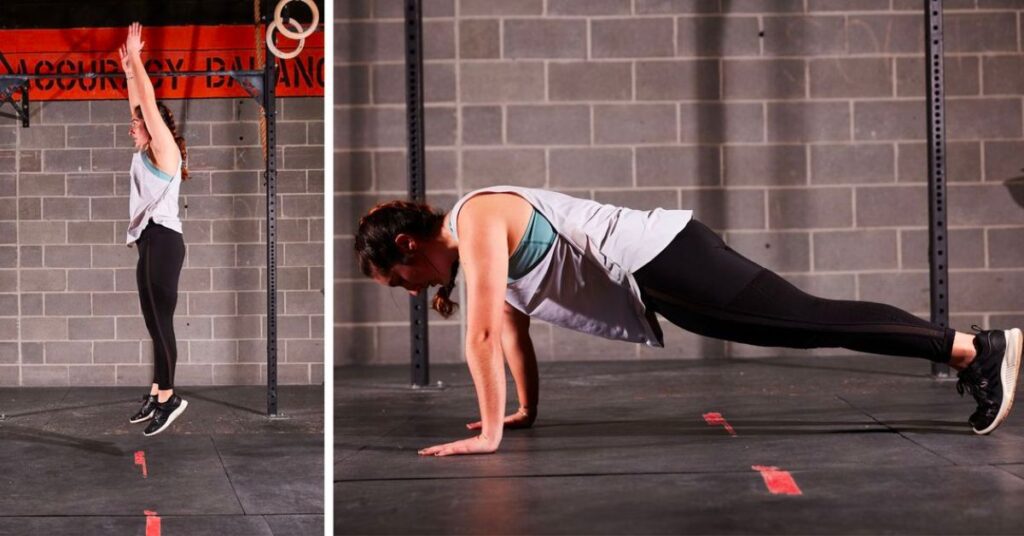
Ah, the renowned burpees – a love-hate relationship epitomized among circuit training exercises without equipment.
This dynamic and high-intensity maneuver remains a favorite among fitness enthusiasts for its capacity to engage multiple muscle groups and elevate the heart rate in a single explosive motion.
Prepare to unleash your inner athlete as we delve into the steps of this challenging yet exhilarating exercise:
- Step 1: Starting Position: Commence in a standing stance with feet shoulder-width apart. Keep your arms at your sides.
- Step 2: Squat Down: Lower your body into a squat position by bending your knees. Place your hands on the floor in front of you, just outside your feet.
- Step 3: Kick Back: Kick your feet back one at a time, landing in a plank position. Your body should form a straight line from head to heels.
- Step 4: Push-Up (Optional): For heightened challenge, execute a push-up while in the plank position. Lower your chest toward the floor, keeping elbows close to your body, then push back up.
- Step 5: Return to Squat Position: Jump your feet forward, landing back into the squat position.
- Step 6: Explosive Jump: From the squat position, explode upward with a powerful jump, extending your arms overhead.
- Step 7: Land Softly: As you land, ensure a soft landing by bending your knees to absorb impact.
- Step 8: Repeat: Proceed immediately into the next repetition to maintain exercise intensity and fluidity.
9. High Knees

High knees are a dynamic and invigorating exercise that will elevate your heart rate and add a burst of intensity to your circuit training workout.
This movement mimics running in place while engaging your core, legs, and cardiovascular system.
As you lift your knees towards your chest, you’ll feel the burn and unleash a surge of energy, making it a perfect addition to your bodyweight circuit routine.
Let’s go through the steps to perform high knees with precision and power:
Steps:
- Stand Tall: Begin by standing with your feet shoulder-width apart and your arms hanging down by your sides.
- Engage Your Core: Tighten your core muscles to stabilize your body during the exercise.
- Lift Your Knees: Lift your right knee towards your chest as high as you can, while simultaneously raising your left arm.
- Switch Legs and Arms: As you lower your right leg back to the ground, lift your left knee towards your chest, and raise your right arm.
- Maintain a Rhythmic Pace: Continue to alternate between lifting your knees and swinging your arms, creating a smooth and rhythmic motion. Try to increase the pace to elevate your heart rate.
- Land Softly: As you lift your knees, be sure to land gently on the balls of your feet to reduce impact and minimize strain on your joints.
- Stay Light on Your Feet: Keep your weight slightly forward and avoid heavy pounding on the ground to maintain agility and reduce the risk of injury.
- Look Forward: Keep your gaze forward to maintain proper posture and alignment throughout the exercise.
- Breath Regularly: Remember to breathe steadily throughout the movement, taking deep breaths to supply oxygen to your working muscles.
Sample Circuit Training Routine
This circuit training routine is designed to target multiple muscle groups and elevate your heart rate, all without the need for any equipment.
Perform each exercise with proper form and intensity to maximize the benefits. Aim to complete the entire circuit without taking extended breaks between exercises.
After completing the circuit, rest for 1-2 minutes before starting the next round. Repeat the circuit 3-4 times for a full-body, high-intensity workout!
Exercise 1: Bodyweight Squats
- Reps: 15 squats
- Sets: 3 sets
Exercise 2: Push-Ups
- Reps: 12 push-ups
- Sets: 3 sets
Exercise 3: Mountain Climbers
- Reps: 30 seconds (as many reps as possible within the time)
- Sets: 3 sets
Exercise 4: Plank Variations
- Regular Plank: Hold for 30 seconds
- Side Plank (each side): Hold for 20 seconds
- Plank Rotations: 10 rotations (5 each side)
- Sets: 3 sets
Exercise 5: Jump Lunges
- Reps: 12 lunges (6 each leg)
- Sets: 3 sets
Exercise 6: Triceps Dips
- Reps: 12 dips
- Sets: 3 sets
Exercise 7: Bicycle Crunches
- Reps: 20 crunches (10 each side)
- Sets: 3 sets
Exercise 8: Burpees
- Reps: 10 burpees
- Sets: 3 sets
Exercise 9: High Knees
- Reps: 30 seconds (as many reps as possible within the time)
- Sets: 3 sets
Instructions:
- Begin with Exercise 1 (Bodyweight Squats), perform 15 reps, and then move on to Exercise 2 (Push-Ups) for 12 reps. Continue in this manner until you have completed all nine exercises in the circuit.
- After completing one round of the circuit, take a 1–2-minute rest before starting the next round.
- Aim to perform each exercise with proper form and control. If you are new to circuit training, take it at your own pace and gradually increase the intensity as you become more comfortable with the movements.
- Adjust the number of sets and reps based on your fitness level. You can increase or decrease the intensity to suit your abilities and gradually progress as you become stronger and more confident.
- Don’t forget to stay hydrated throughout the workout and perform a cool-down and stretching session at the end to help your muscles recover.
Tips for Success
Circuit training without equipment offers a flexible and effective way to achieve your fitness objectives while eliminating the need for specialized gym gear.
To make the most out of your bodyweight circuit training routine and ensure success, follow these valuable tips:
- Start with a Warm-Up: Always begin your circuit training session with a proper warm-up. Engaging in dynamic movements like jumping jacks, leg swings, and high knees will increase blood flow, elevate your heart rate, and prepare your muscles for the upcoming exercises.
- Master Proper Form: Focus on maintaining proper form during each exercise. Performing movements with correct posture reduces the risk of injury and optimizes the effectiveness of the workout. If you’re unsure about a specific exercise, watch instructional videos or seek guidance from a fitness professional.
- Listen to Your Body: Pay attention to your body and adjust the intensity according to your fitness level. If an exercise feels too challenging or causes discomfort, modify it or choose an alternative that suits you better. Progress gradually and push yourself within your limits.
- Balance Intensity and Rest: Circuit training is designed to be intense, but it’s essential to find the right balance between effort and rest. Allocate sufficient rest periods between exercises or circuits to allow your muscles to recover while keeping your heart rate elevated.
- Stay Hydrated: Drink water before, during, and after your workout to stay hydrated. Proper hydration supports optimal performance and helps prevent dehydration, which can lead to fatigue and reduced exercise performance.
- Incorporate a Variety of Exercises: Keep your workouts exciting and engaging by incorporating a variety of bodyweight exercises. This diversity not only targets different muscle groups but also prevents boredom and plateaus, leading to continuous progress.
- Create a Circuit Plan: Plan your circuit training routine in advance. Determine the exercises, reps, sets, and rest periods, and stick to the plan during your workout. This structure will help you stay focused and make the most out of your training session.
Conclusion
In conclusion, circuit training without equipment offers a convenient, effective, and versatile approach to achieving your fitness goals.
With a wide range of bodyweight exercises and the flexibility to adapt the workout to your fitness level, you can elevate your cardiovascular endurance, build strength, and burn calories right from the comfort of your home or any suitable space.
By following proper form, incorporating variety, and listening to your body, you can make the most out of your circuit training routine. Embrace this dynamic workout method, stay consistent, and witness the remarkable improvements in your overall fitness and well-being.
Get ready to conquer your fitness journey with the power of bodyweight circuit training.

